Effects of High Temperature and Cooling Regimes on Properties of Marble Powder-Based Cementitious Composites
Abstract
:1. Introduction
2. Experimental Program
2.1. Materials
2.2. Mixture Proportions
2.3. Test Procedure
3. Results and Discussion
3.1. Unit Weight
3.1.1. The Uw Findings for the Samples Air-Cooled after High-Temperature Exposure
3.1.2. The Uw Findings for Samples Cooled with Water after Exposure to High Temperatures
3.1.3. Comparison of Uw Findings for Samples Cooled in Air and Water after High-Temperature Exposure
3.2. Ultrasonic Pulse Velocity (UPV)
3.2.1. The UPV Findings for Air-Cooled Samples
3.2.2. The UPV Findings for Water-Cooled Samples
3.2.3. Comparison of UPV Findings for Samples Cooled in Air and Water
3.3. Compressive Strength
3.3.1. The fcs Values of the Samples Air-Cooled after High-Temperature Exposure
3.3.2. The fcs Values of the Samples Water-Cooled after High-Temperature Exposure
3.3.3. Comparison of fcs Findings for Samples Cooled in Air and Water after High-Temperature Exposure
3.4. Flexural Strength
3.4.1. The ffs Values of the Samples Air-Cooled after High-Temperature Exposure
3.4.2. The ffs Values of the Samples Water-Cooled after High-Temperature Exposure
3.4.3. Comparison of ffs Findings for Samples Cooled in Air and Water
3.5. Mass Loss
3.5.1. The Mass Loss Values of the Air-Cooled Samples
3.5.2. The Mass Loss Values of the Water-Cooled Samples
3.5.3. Comparison of Mass Loss Findings for Samples Cooled in Air and Water
3.6. Microstructural Analyses
4. Conclusions
- With an increase in the replacement percentage of MP, Uw values decreased. This can be attributed to the lower specific gravity of MP compared with cement. The Uw values of specimens cooled in water were higher than those of specimens cooled in air. This is because, after high-temperature exposure, the dehydration of calcium hydroxide (CH) results in its conversion to CaO, which undergoes rehydration during water cooling.
- UPV values decreased with an increase in the MP replacement percentage. This decrease might be attributed to reduced hydrated elements due to higher MP content, leading to a more porous cement matrix. The UPV values of specimens cooled in air are higher than those of specimens cooled in water. Rapid water cooling induces additional stress and cracks in the cement matrix, making the specimens more porous. Consequently, the UPV values of specimens cooled in water are lower than those of specimens cooled in air.
- The results obtained from fcs and ffs showed a similar trend. The best mechanical properties were observed in specimens with 5% MP replacement. As the replacement percentage increases, a deterioration in mechanical properties is observed. The fcs and ffs values of specimens cooled in water were lower than those of specimens cooled in air. This deterioration became more pronounced with an increase in the exposure temperature. The reduced mechanical properties of specimens cooled in water can be attributed to the additional stress and cracks induced by rapid cooling.
- The mass losses of all specimens increased with higher temperatures. This is attributed to the breakdown of hydrated elements with increasing temperature. An increase in the MP replacement percentage results in decreased mass losses. The mass losses of specimens cooled in air were higher than those of specimens cooled in water. This is due to the dehydration of CH into CaO after temperature exposure, followed by rehydration of CaO during water cooling. Rehydrated CaO absorbs water, increasing the mass of the specimen.
Author Contributions
Funding
Institutional Review Board Statement
Informed Consent Statement
Data Availability Statement
Conflicts of Interest
References
- Habert, G.; Bouzidi, Y.; Chen, C.; Jullien, A. Development of a depletion indicator for natural resources used in concrete. Resour. Conserv. Recycl. 2010, 54, 364–376. [Google Scholar] [CrossRef]
- Khan, E.U.; Khushnood, R.A.; Baloch, W.L. Spalling sensitivity and mechanical response of an ecofriendly sawdust high strength concrete at elevated temperatures. Constr. Build. Mater. 2020, 258, 119656. [Google Scholar] [CrossRef]
- Demir, İ.; Güzelkücük, S.; Sevim, Ö. Effects of sulfate on cement mortar with hybrid pozzolan substitution. Eng. Sci. Technol. Int. J. 2018, 21, 275–283. [Google Scholar] [CrossRef]
- Sun, Y.; Wang, K.Q.; Lee, H.S. Prediction of compressive strength development for blended cement mortar considering fly ash fineness and replacement ratio. Constr. Build. Mater. 2021, 271, 121532. [Google Scholar] [CrossRef]
- Kanagaraj, B.; Anand, N.; Andrushia, A.D.; Lubloy, E. Investigation on engineering properties and micro-structure characteristics of low strength and high strength geopolymer composites subjected to standard temperature exposure. Case Stud. Constr. Mater. 2022, 17, e01608. [Google Scholar] [CrossRef]
- Alakara, E.H.; Nacar, S.; Sevim, O.; Korkmaz, S.; Demir, I. Determination of compressive strength of perlite-containing slag-based geopolymers and its prediction using artificial neural network and regression-based methods. Constr. Build. Mater. 2022, 359, 129518. [Google Scholar] [CrossRef]
- Sevim, O.; Alakara, E.H.; Demir, I.; Bayer, I.R. Effect of magnetic water on properties of slag-based geopolymer composites incorporating ceramic tile waste from construction and demolition waste. Arch. Civ. Mech. Eng. 2023, 23, 107. [Google Scholar] [CrossRef]
- Altiok, M.; Alakara, E.H.; Gündüz, M.; Ağaoğlu, M.N. A multi-objective genetic algorithm for the hot mix asphalt problem. Neural Comput. Appl. 2023, 35, 8197–8225. [Google Scholar] [CrossRef]
- Danish, A.; Öz, A.; Bayrak, B.; Kaplan, G.; Aydın, A.C.; Ozbakkaloglu, T. Performance evaluation and cost analysis of prepacked geopolymers containing waste marble powder under different curing temperatures for sustainable built environment. Resour. Conserv. Recycl. 2023, 192, 106910. [Google Scholar] [CrossRef]
- Aliabdo, A.A.; Abd Elmoaty, M.; Auda, E.M. Re-use of waste marble dust in the production of cement and concrete. Constr. Build. Mater. 2014, 50, 28–41. [Google Scholar] [CrossRef]
- Rana, A.; Kalla, P.; Csetenyi, L.J. Sustainable use of marble slurry in concrete. J. Cleaner Prod. 2015, 94, 304–311. [Google Scholar] [CrossRef]
- Varadharajan, S.; Jaiswal, A.; Verma, S. Assessment of mechanical properties and environmental benefits of using rice husk ash and marble dust in concrete. Structures 2020, 28, 389–406. [Google Scholar] [CrossRef]
- Corinaldesi, V.; Moriconi, G. Influence of mineral additions on the performance of 100% recycled aggregate concrete. Constr. Build. Mater. 2009, 23, 2869–2876. [Google Scholar] [CrossRef]
- Aydın, E. Effects of elevated temperature for the marble cement paste products for better sustainable construction. J. Polytech. 2019, 22, 259–267. [Google Scholar]
- Parmar, S.; Das, S.K. Effect of marble slurry as a partial substitution of ordinary Portland cement in lean concrete mixes. Struct. Concr. 2021, 22, E514–E527. [Google Scholar] [CrossRef]
- Vardhan, K.; Goyal, S.; Siddique, R.; Singh, M. Mechanical properties and microstructural analysis of cement mortar incorporating marble powder as partial replacement of cement. Constr. Build. Mater. 2015, 96, 615–621. [Google Scholar] [CrossRef]
- Singh, M.; Srivastava, A.; Bhunia, D. An investigation on effect of partial replacement of cement by waste marble slurry. Constr. Build. Mater. 2017, 134, 471–488. [Google Scholar] [CrossRef]
- Siddique, S.; Jang, J.G.; Gupta, T. Developing marble slurry as supplementary cementitious material through calcination: Strength and microstructure study. Constr. Build. Mater. 2021, 293, 123474. [Google Scholar] [CrossRef]
- Khaliq, W.; Khan, H.A. High temperature material properties of calcium aluminate cement concrete. Constr. Build. Mater. 2015, 94, 475–487. [Google Scholar] [CrossRef]
- Karakoç, M.B. Effect of cooling regimes on compressive strength of concrete with lightweight aggregate exposed to high temperature. Constr. Build. Mater. 2013, 41, 21–25. [Google Scholar] [CrossRef]
- Baradaran-Nasiri, A.; Nematzadeh, M. The effect of elevated temperatures on the mechanical properties of concrete with fine recycled refractory brick aggregate and aluminate cement. Constr. Build. Mater. 2017, 147, 865–875. [Google Scholar] [CrossRef]
- Gökçe, H.S. High temperature resistance of boron active belite cement mortars containing fly ash. J. Cleaner Prod. 2019, 211, 992–1000. [Google Scholar] [CrossRef]
- Karahan, O.; Durak, U.; İlkentapar, S.; Atabey, İ.İ.; Atiş, C.D. Resistance of polypropylene fibered mortar to elevated temperature under different cooling regimes. Rev. Constr. 2019, 18, 386–397. [Google Scholar] [CrossRef]
- Sevim, O.; Demir, I.; Alakara, E.H.; Bayer, İ.R. Experimental Evaluation of New Geopolymer Composite with Inclusion of Slag and Construction Waste Firebrick at Elevated Temperatures. Polymers 2023, 15, 2127. [Google Scholar] [CrossRef]
- Baran, Y.; Gökçe, H.S.; Durmaz, M. Physical and mechanical properties of cement containing regional hazelnut shell ash wastes. J. Cleaner Prod. 2020, 259, 120965. [Google Scholar] [CrossRef]
- Wong, C.L.; Mo, K.H.; Alengaram, U.J.; Yap, S.P. Mechanical strength and permeation properties of high calcium fly ash-based geopolymer containing recycled brick powder. J. Build. Eng. 2020, 32, 101655. [Google Scholar] [CrossRef]
- Arif, R.; Khitab, A.; Kırgız, M.S.; Khan, R.B.N.; Tayyab, S.; Khan, R.A.; Tayyab, S.; Khan, R.A.; Anwar, W.; Arshad, M.T. Experimental analysis on partial replacement of cement with brick powder in concrete. Case Stud. Constr. Mater. 2021, 15, e00749. [Google Scholar] [CrossRef]
- Sevim, O.; Demir, İ.; Alakara, E.H.; Guzelkucuk, S.; Bayer, İ.R. The Effect of Magnetized Water on the Fresh and Hardened Properties of Slag/Fly Ash-Based Cementitious Composites. Buildings 2023, 13, 271. [Google Scholar] [CrossRef]
- Yamanel, K.; Durak, U.; İlkentapar, S.; Atabey, İ.İ.; Karahan, O.; Duran, C. Influence of waste marble powder as a replacement of cement on the properties of mortar. Rev. Constr. 2019, 18, 290–300. [Google Scholar] [CrossRef]
- Jiang, X.; Xiao, R.; Bai, Y.; Huang, B.; Ma, Y. Influence of waste glass powder as a supplementary cementitious material (SCM) on physical and mechanical properties of cement paste under high temperatures. J. Cleaner Prod. 2019, 340, 130778. [Google Scholar] [CrossRef]
- TS EN 196-1; Methods of Testing Cement–Part 1: Determination of Strength. Turkish Standards Institution: Ankara, Turkey, 2016.
- Nematzadeh, M.; Dashti, J.; Ganjavi, B. Optimizing compressive behavior of concrete containing fine recycled refractory brick aggregate together with calcium aluminate cement and polyvinyl alcohol fibers exposed to acidic environment. Constr. Build. Mater. 2018, 164, 837–849. [Google Scholar] [CrossRef]
- Khattab, M.; Hachemi, S.; Al Ajlouni, M.F. Evaluating the physical and mechanical properties of concrete prepared with recycled refractory brick aggregates after elevated temperatures’ exposure. Constr. Build. Mater. 2021, 311, 125351. [Google Scholar] [CrossRef]
- Gao, F.; Ji, Y.; Zhang, L.; Zhang, Z.; Xue, Q. High temperature resistance of a phase change cementitious material at elevated temperatures. Constr. Build. Mater. 2021, 292, 123456. [Google Scholar] [CrossRef]
- Mijowska, E.; Horszczaruk, E.; Sikora, P.; Cendrowski, K. The effect of nanomaterials on thermal resistance of cement-based composites exposed to elevated temperature. Mater. Today Proc. 2018, 5, 15968–15975. [Google Scholar] [CrossRef]
- Georgali, B.; Tsakiridis, P.E. Microstructure of fire-damaged concrete. A case study. Cem. Concr. Compos. 2005, 27, 255–259. [Google Scholar] [CrossRef]
- Alakara, E.H.; Sevim, O.; Demir, I.; Şimşek, O. Experimental study on firebrick powder-based cementitious composites under the effect of elevated temperature. J. Build. Eng. 2022, 61, 105277. [Google Scholar] [CrossRef]
- ASTM C642-13; Standard Test Method for Density, in Absorption, and Voids in Hardened Concrete. ASTM International: West Conshohocken, PA, USA, 2013.
- ASTM C597-16; Standard Test Method for Pulse Velocity Through Concrete. ASTM International: West Conshohocken, PA, USA, 2016.
- Whitehurst, E. Soniscope tests concrete structures. J. Am. Concr. Inst. 1951, 47, 433–444. [Google Scholar]
- Qasrawi, H.Y. Concrete strength by combined nondestructive methods simply and reliably predicted. Cem. Concr. Res. 2000, 30, 739–746. [Google Scholar] [CrossRef]
- Seghir, N.T.; Mellas, M.; Sadowski, Ł.; Żak, A. Effects of marble powder on the properties of the air-cured blended cement paste. J. Cleaner Prod. 2018, 183, 858–868. [Google Scholar] [CrossRef]
- Sarıdemir, M.; Çelikten, S.; Yıldırım, A. Mechanical and microstructural properties of calcined diatomite powder modified high strength mortars at ambient and high temperatures. Adv. Powder Technol. 2020, 31, 3004–3017. [Google Scholar] [CrossRef]
- Hiremath, P.N.; Yaragal, S.C. Performance evaluation of reactive powder concrete with polypropylene fibers at elevated temperatures. Constr. Build. Mater. 2018, 169, 499–512. [Google Scholar] [CrossRef]
- Arioz, O. Retained properties of concrete exposed to high temperatures: Size effect. Fire Mater. 2009, 33, 211–222. [Google Scholar] [CrossRef]
- Al-Mutairi, N.; Terro, M.; Al-Khaleefi, A.L. Effect of recycling hospital ash on the compressive properties of concrete: Statistical assessment and predicting model. Build. Environ. 2004, 39, 557–566. [Google Scholar] [CrossRef]
- Ibrahim, R.K.; Ramyar, K.; Hamid, R.; Raihan Tah, M. The effect of high temperature on mortars containing silica fume. J. Appl. Sci. 2011, 11, 2666–2669. [Google Scholar] [CrossRef]
- AzariJafari, H.; Amiri, M.J.T.; Ashrafian, A.; Rasekh, H.; Barforooshi, M.J.; Berenjian, J. Ternary blended cement: An eco-friendly alternative to improve resistivity of high-performance self-consolidating concrete against elevated temperature. J. Cleaner Prod. 2019, 223, 575–586. [Google Scholar] [CrossRef]
- Topcu, I.B.; Demir, A. Effect of fire and elevated temperatures on reinforced concrete structures. Bull. Chamber Civ. Eng. 2002, 16, 34–36. [Google Scholar]
- Awal, A.A.; Shehu, I.A.; Ismail, M. Effect of cooling regime on the residual performance of high-volume palm oil fuel ash concrete exposed to high temperatures. Constr. Build. Mater. 2015, 98, 875–883. [Google Scholar] [CrossRef]
- Kara, İ.B.; Arslan, M. Effects of plasticizer and antifreeze on concrete at elevated temperatures and different cooling regimes. Rev. Constr. 2020, 19, 347–357. [Google Scholar]
- Benaicha, M.; Jalbaud, O.; Alaoui, A.H.; Burtschell, Y. Correlation between the mechanical behavior and the ultrasonic velocity of fiber-reinforced concrete. Constr. Build. Mater. 2015, 101, 702–709. [Google Scholar] [CrossRef]
- Mashaly, A.O.; El-Kaliouby, B.A.; Shalaby, B.N.; El–Gohary, A.M.; Rashwan, M.A. Effects of marble sludge incorporation on the properties of cement composites and concrete paving blocks. J. Cleaner Prod. 2015, 112, 731–741. [Google Scholar] [CrossRef]
- Dias, W.P.S.; Khoury, G.A.; Sullivan, P.J.E. Mechanical properties of hardened cement paste exposed to temperatures up to 700 C (1292 F). ACI Mater. J. 1990, 87, 160–166. [Google Scholar]
- Alani, S.; Hassan, M.S.; Jaber, A.A.; Ali, I.M. Effects of elevated temperatures on strength and microstructure of mortar containing nano-calcined montmorillonite clay. Constr. Build. Mater. 2020, 263, 120895. [Google Scholar] [CrossRef]
- Wang, W.; Lu, C.; Li, Y.; Li, Q. An investigation on thermal conductivity of fly ash concrete after elevated temperature exposure. Constr. Build. Mater. 2017, 148, 148–154. [Google Scholar] [CrossRef]
- Xie, J.; Zhang, Z.; Lu, Z.; Sun, M. Coupling effects of silica fume and steel-fiber on the compressive behaviour of recycled aggregate concrete after exposure to elevated temperature. Constr. Build. Mater. 2018, 184, 752–764. [Google Scholar] [CrossRef]
- Hertz, K.D. Concrete strength for fire safety design. Mag. Concr. Res. 2005, 57, 445–453. [Google Scholar] [CrossRef]
- Yüzer, N.; Aköz, F.; Öztürk, L.D. Compressive strength–color change relation in mortars at high temperature. Cem. Concr. Res. 2004, 34, 1803–1807. [Google Scholar] [CrossRef]
- Karahan, O. Residual compressive strength of fire-damaged mortar after post-fire-air-curing. Fire Mater. 2011, 35, 561–567. [Google Scholar] [CrossRef]
- Abadel, A.; Elsanadedy, H.; Almusallam, T.; Alaskar, A.; Abbas, H.; Al-Salloum, Y. Residual compressive strength of plain and fiber reinforced concrete after exposure to different heating and cooling regimes. Eur. J. Environ. Civ. Eng. 2022, 26, 6746–6765. [Google Scholar] [CrossRef]
- Gurumoorthy, N. Influence of marble dust as a partial replacement of cement in concrete. Int. J. Eng. Res. Technol. 2014, 4, 740–743. [Google Scholar]
- Ali, M.M.; Hashmi, S.M. An experimental investigation on strengths characteristics of concrete with the partial replacement of cement by marble powder dust and sand by stone dust. Int. J. Sci. Res. Dev. 2014, 2, 360–368. [Google Scholar]
- Sarıdemir, M.; Yıldırım, A. Effect of elevated temperatures on properties of high strength mortars containing ground calcined diatomite with limestone sand. J. Build. Eng. 2022, 56, 104748. [Google Scholar] [CrossRef]
- Nasr, D.; Pakshir, A.H.; Ghayour, H. The influence of curing conditions and alkaline activator concentration on elevated temperature behavior of alkali activated slag (AAS) mortars. Constr. Build. Mater. 2018, 190, 108–119. [Google Scholar] [CrossRef]
- Ameri, F.; Shoaei, P.; Zahedi, M.; Karimzadeh, M.; Musaeei, H.R.; Cheah, C.B. Physico-mechanical properties and micromorphology of AAS mortars containing copper slag as fine aggregate at elevated temperature. J. Build. Eng. 2021, 39, 102289. [Google Scholar] [CrossRef]
- Alarcon-Ruiz, L.; Platret, G.; Massieu, E.; Ehrlacher, A. The use of thermal analysis in assessing the effect of temperature on a cement paste. Cem. Concr. Res. 2005, 35, 609–613. [Google Scholar] [CrossRef]
- Husem, M. The effects of high temperature on compressive and flexural strengths of ordinary and high-performance concrete. Fire Saf. J. 2006, 41, 155–163. [Google Scholar] [CrossRef]
- Sarshar, R.; Khoury, G.A. Material and environmental factors influencing the compressive strength of unsealed cement paste and concrete at high temperatures. Mag. Concr. Res. 1993, 45, 51–61. [Google Scholar] [CrossRef]
- Jacques, K.T.J.; Zengyao, W.; Shoude, W.; Shifeng, H.; Xin, C. The influence of different fine aggregate and cooling regimes on the engineering properties of sulphoaluminate cement mortar after heating. Case Stud. Constr. Mater. 2023, 18, e01866. [Google Scholar] [CrossRef]
- Sevim, O.; Alakara, E.H.; Guzelkucuk, S. Fresh and Hardened Properties of Cementitious Composites Incorporating Firebrick Powder from Construction and Demolition Waste. Buildings 2023, 13, 45. [Google Scholar] [CrossRef]
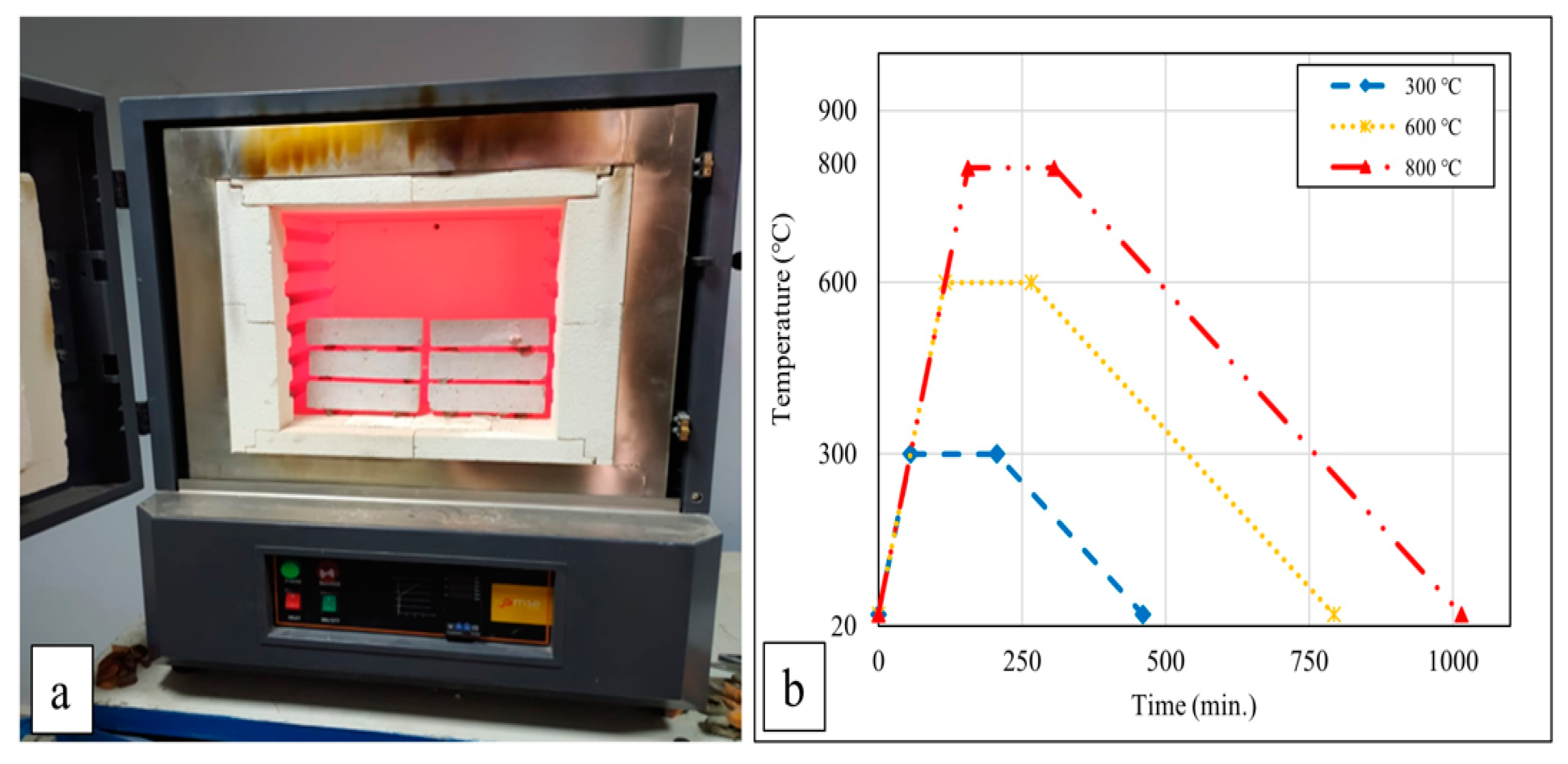


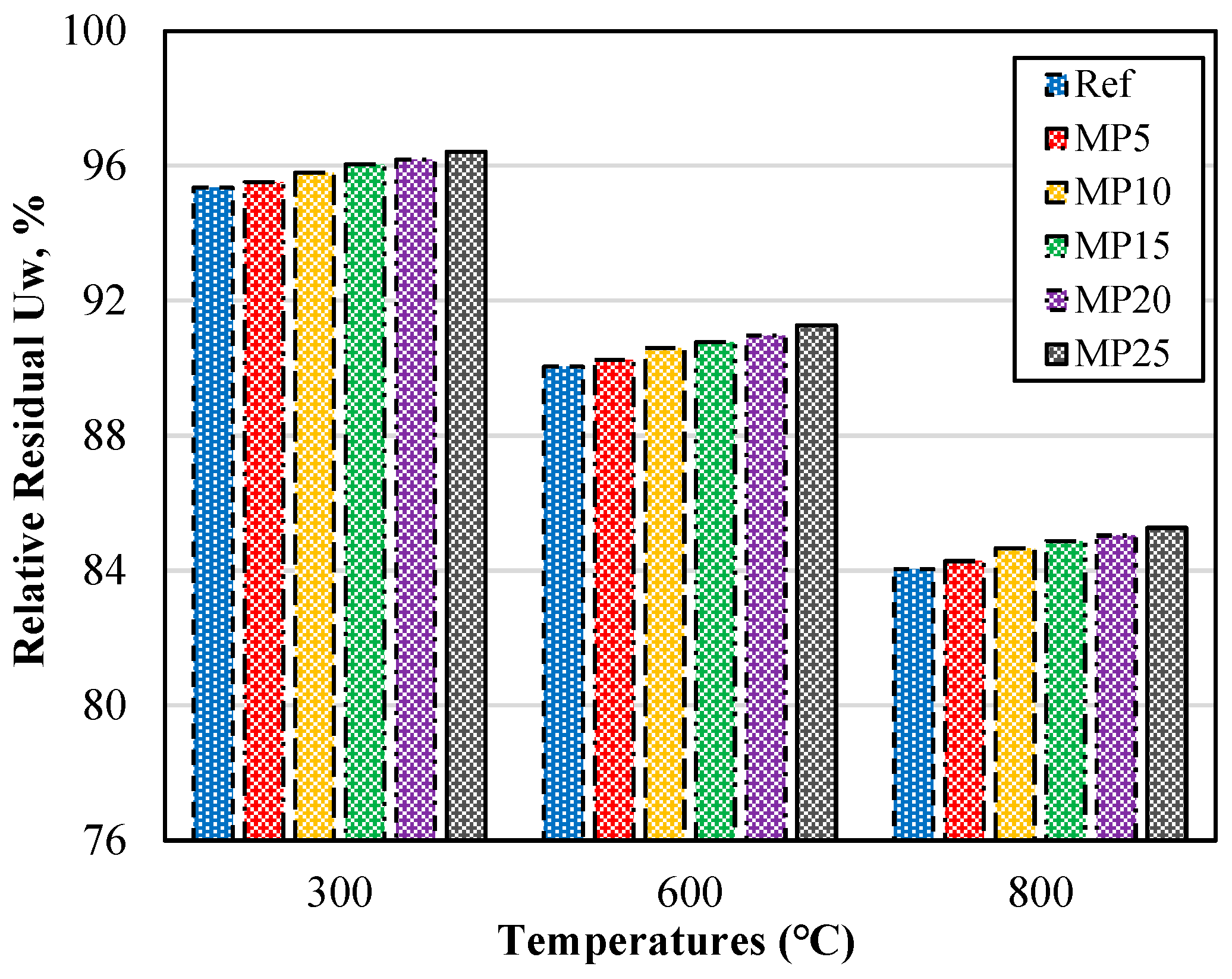
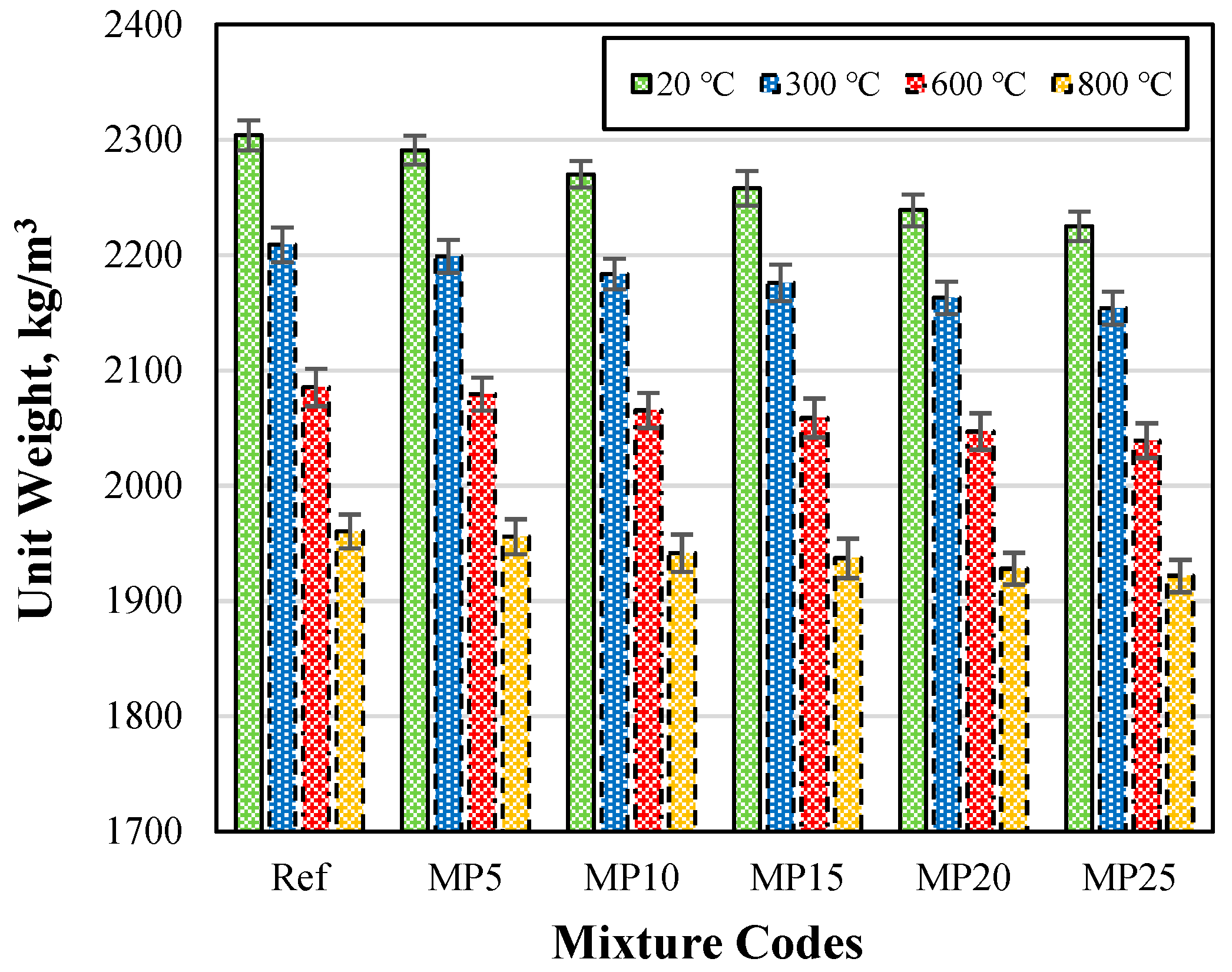
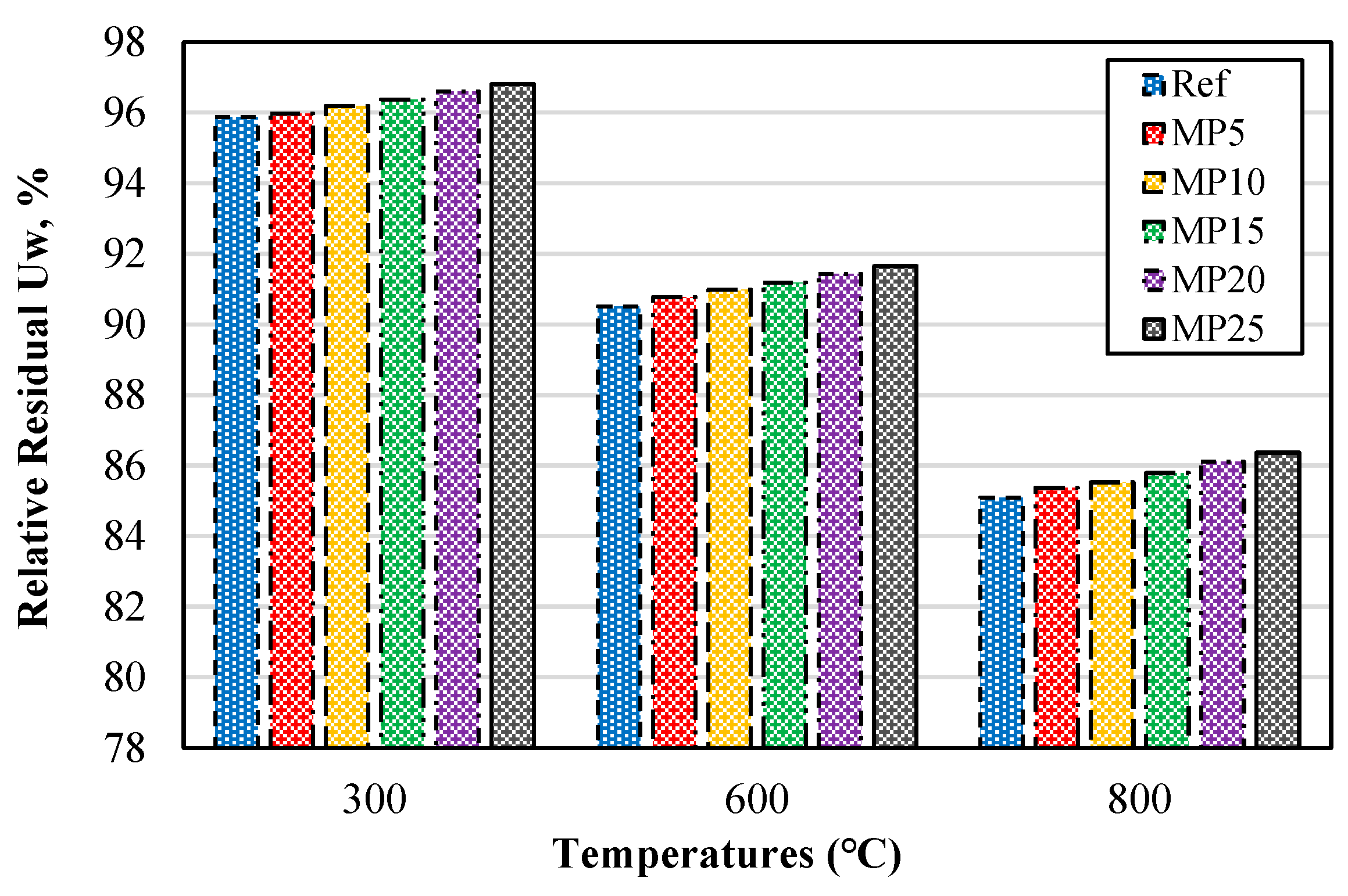

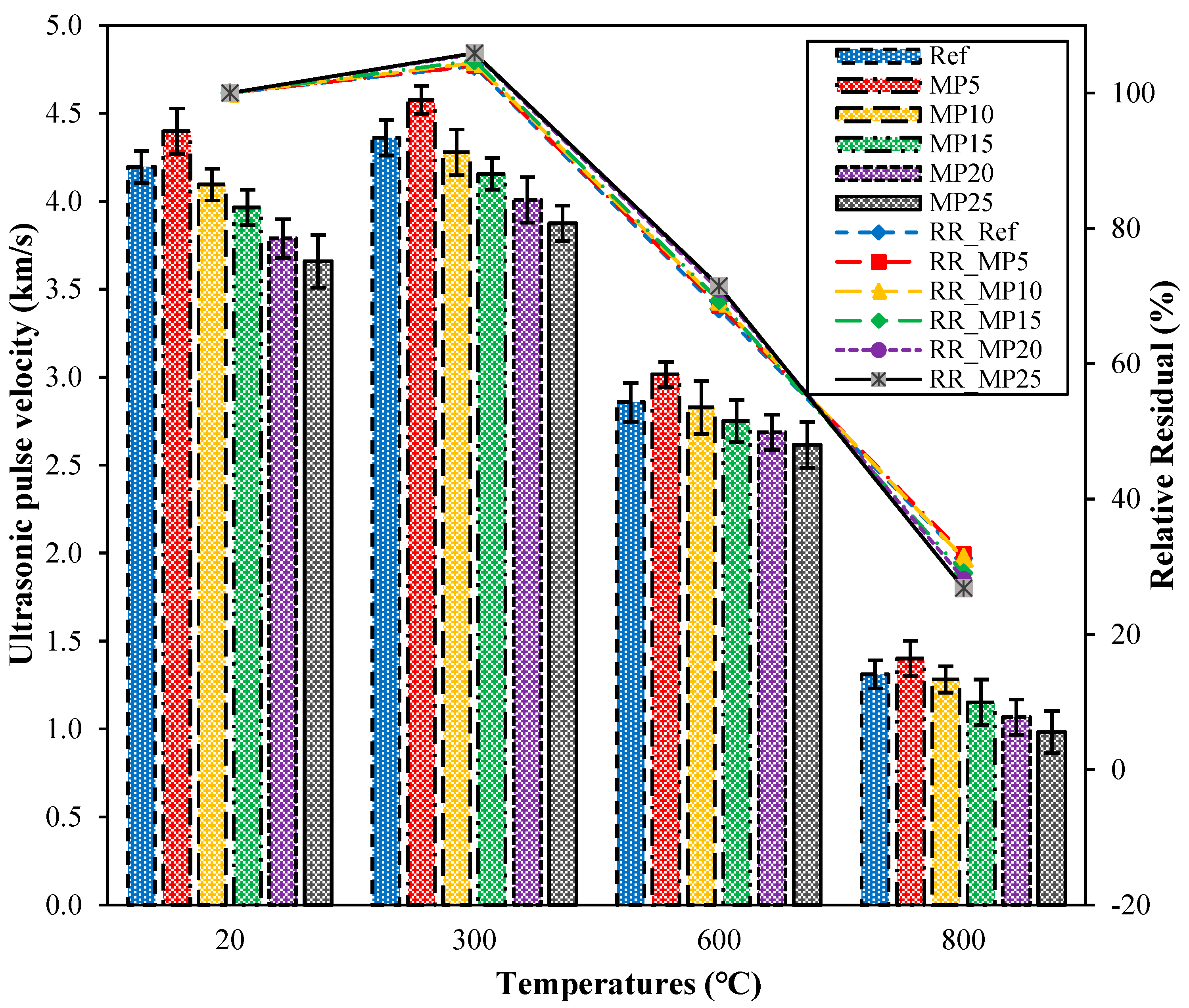

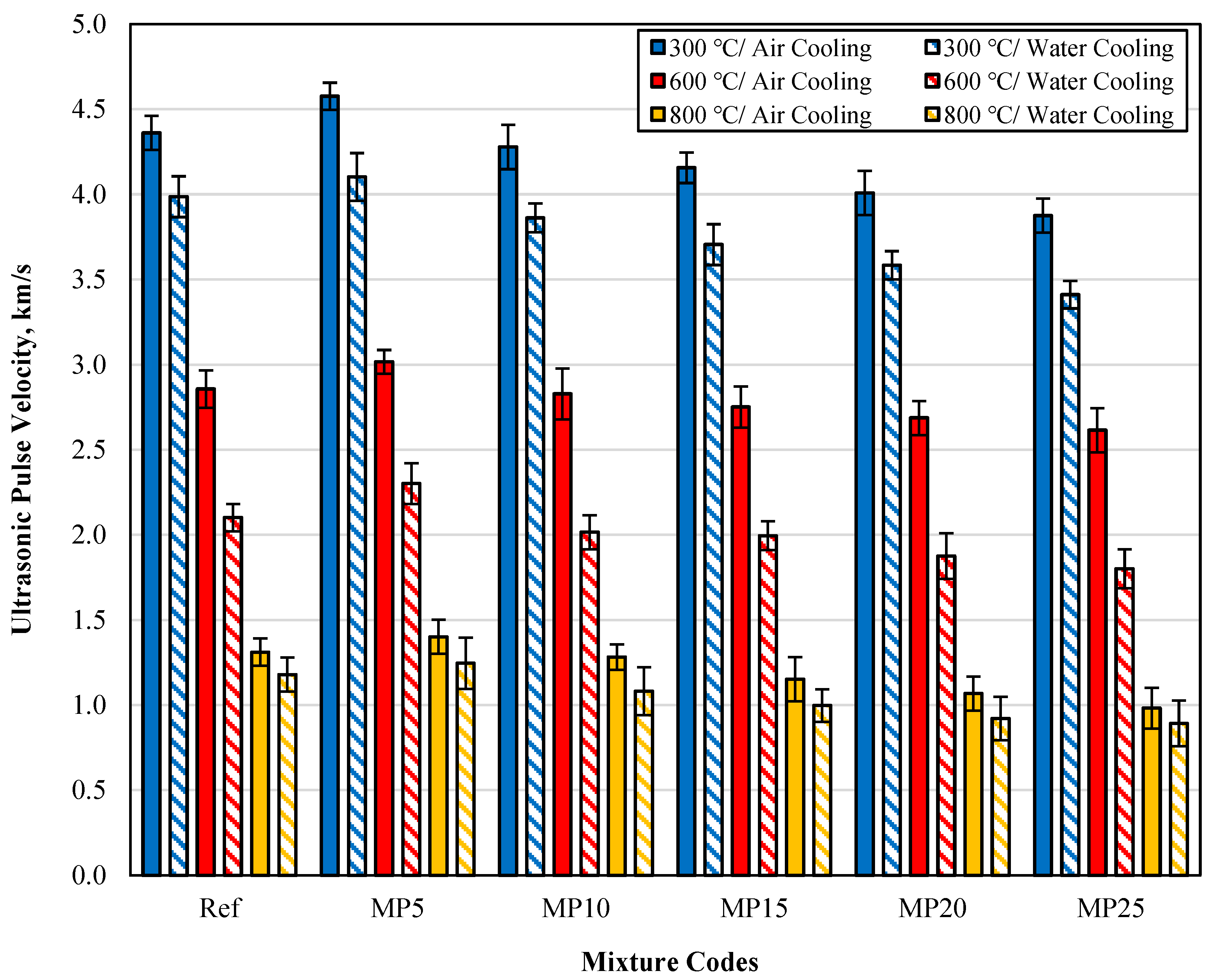

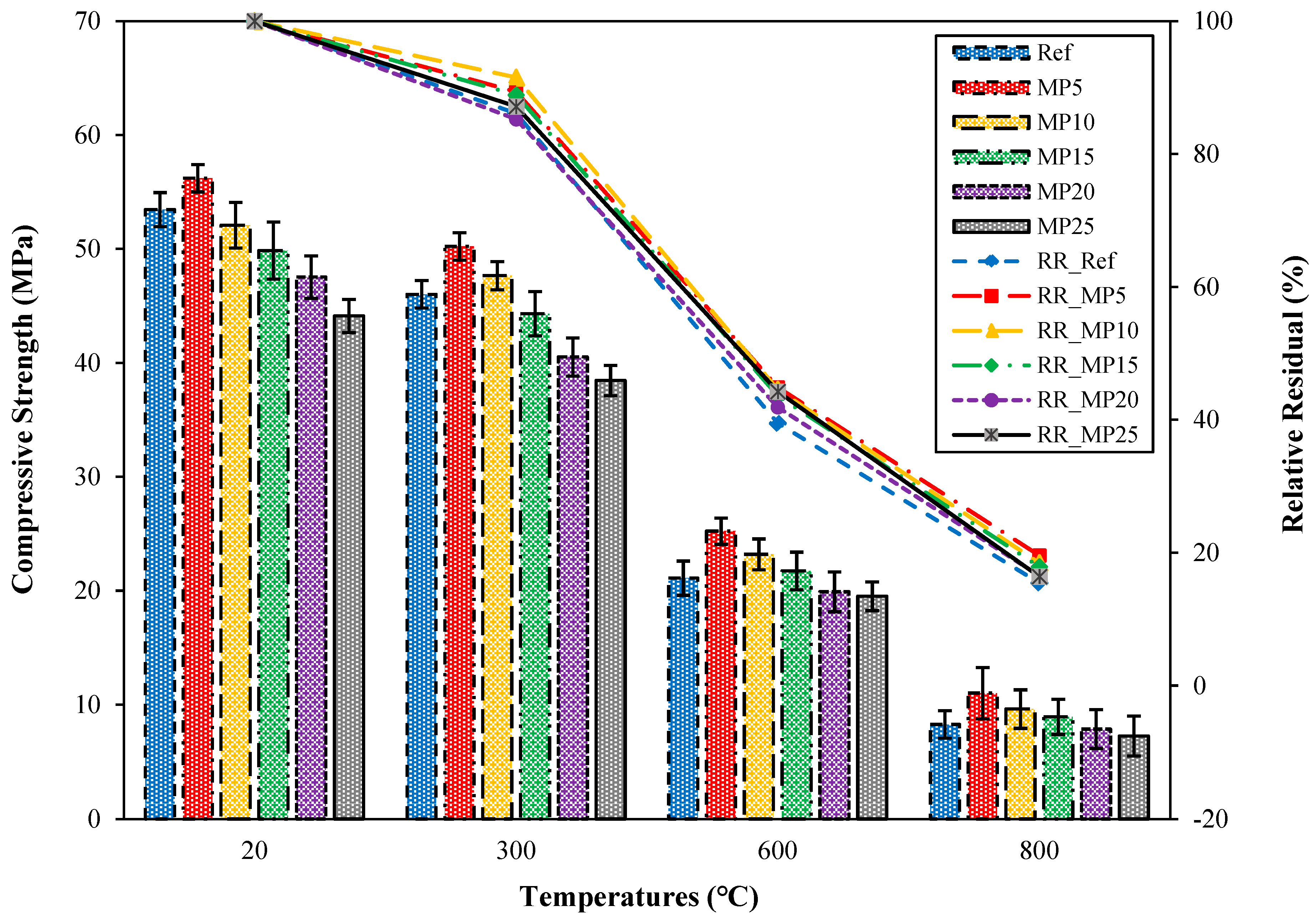
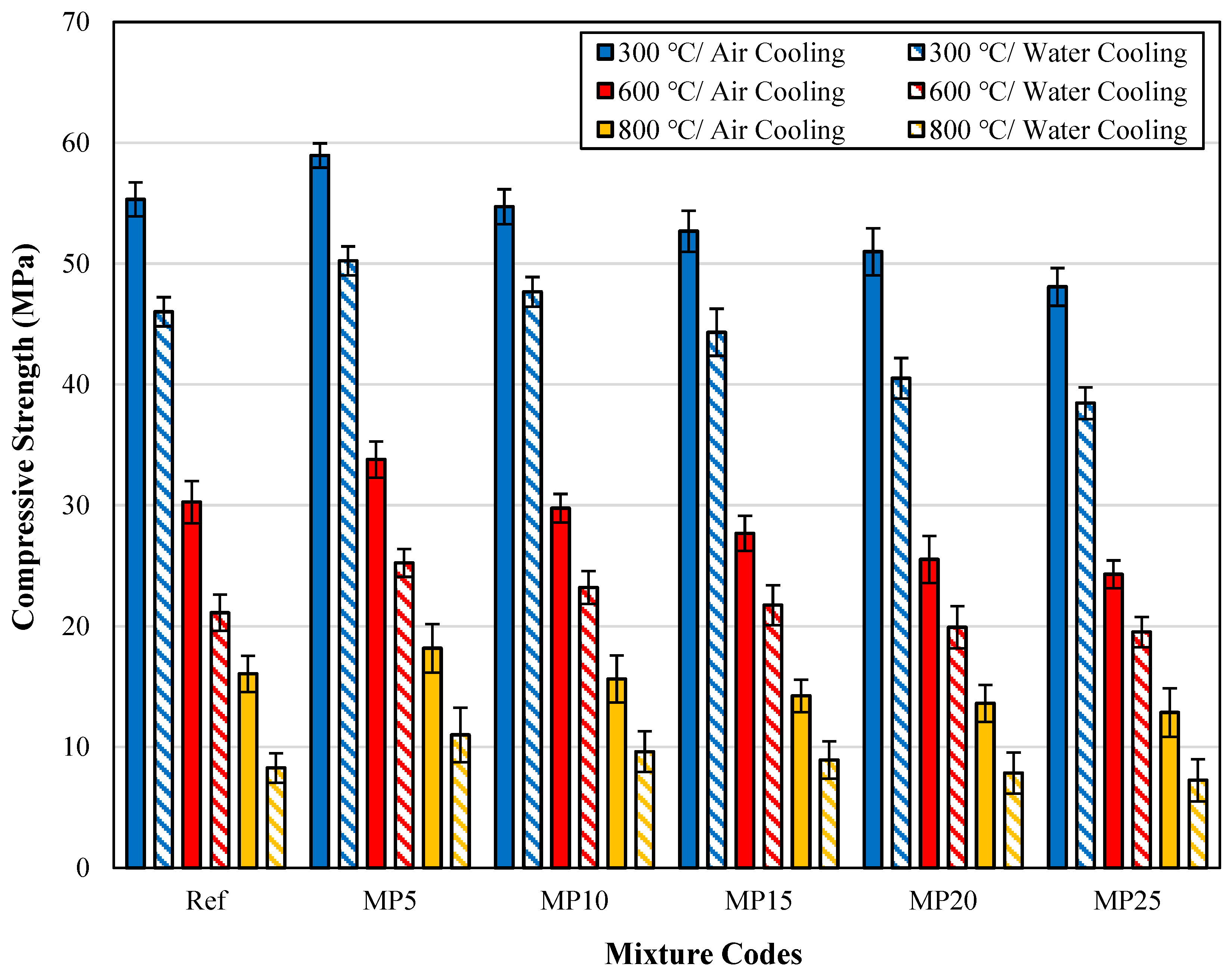


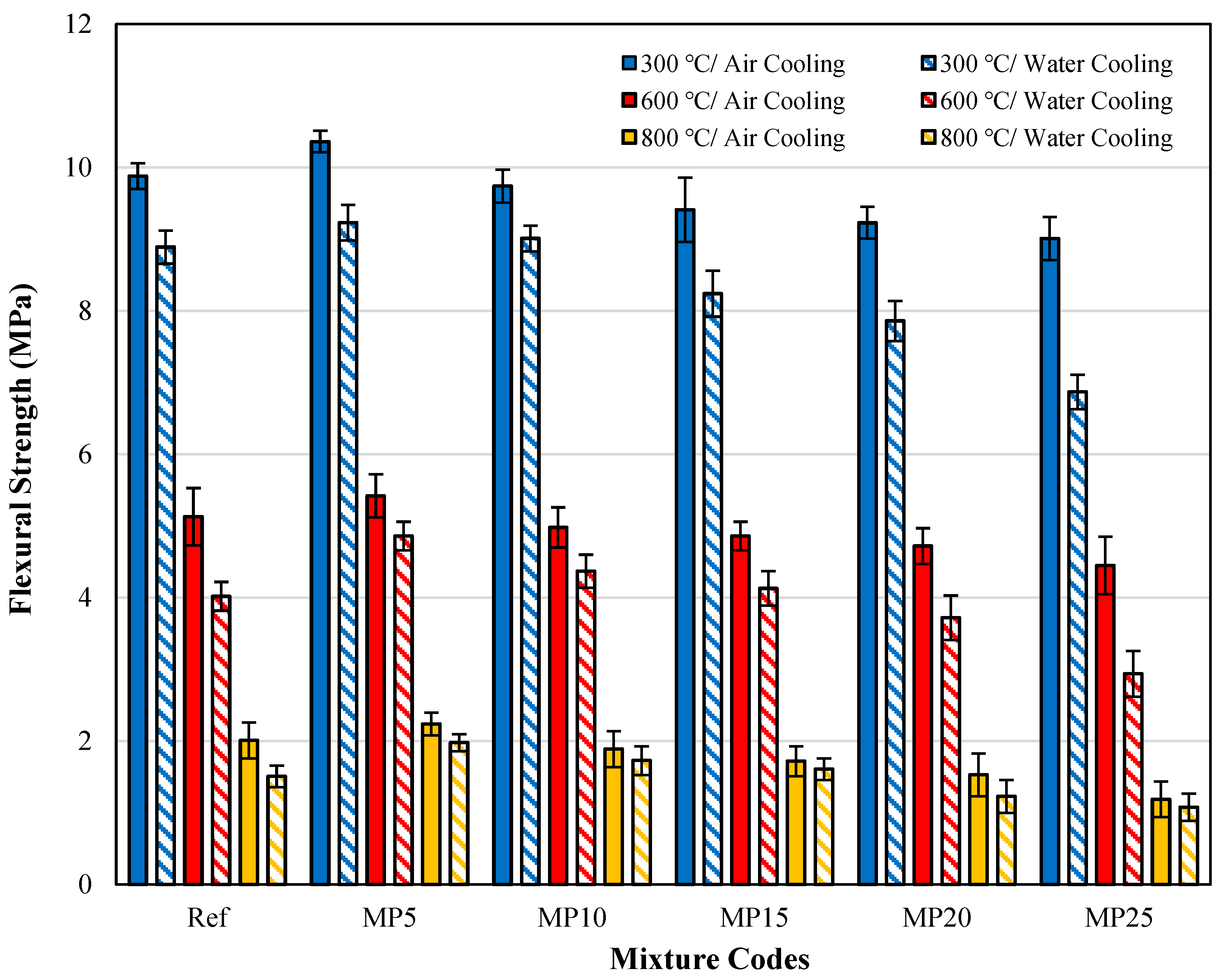


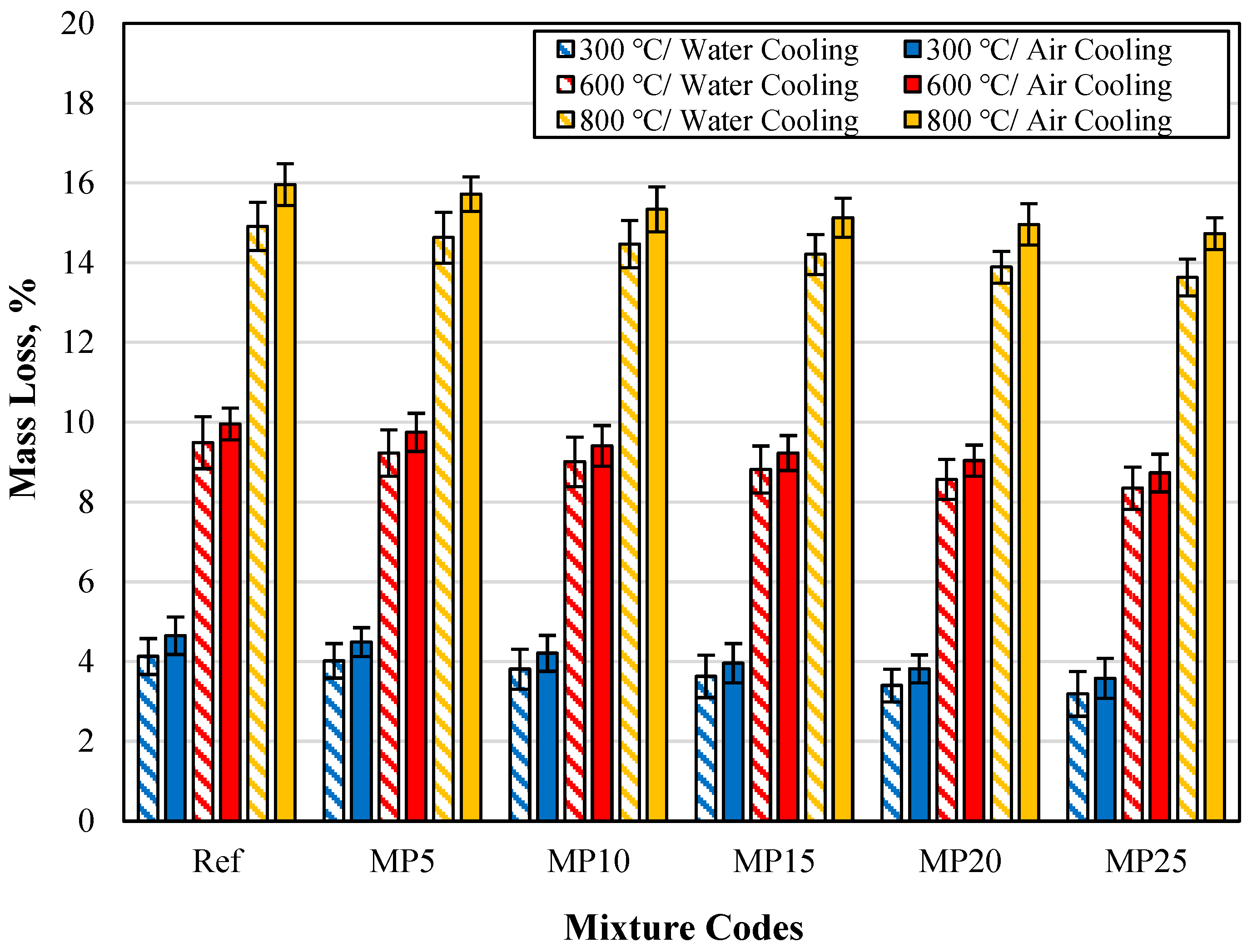

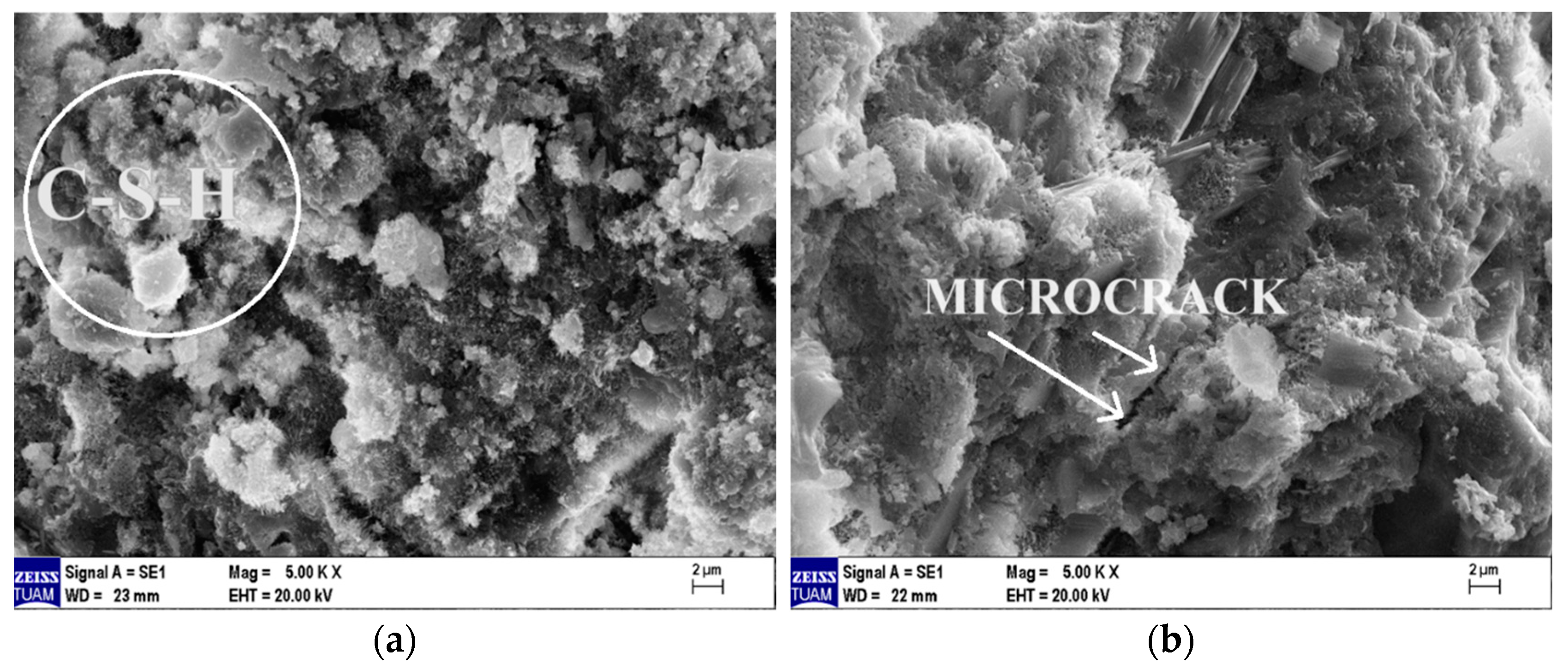
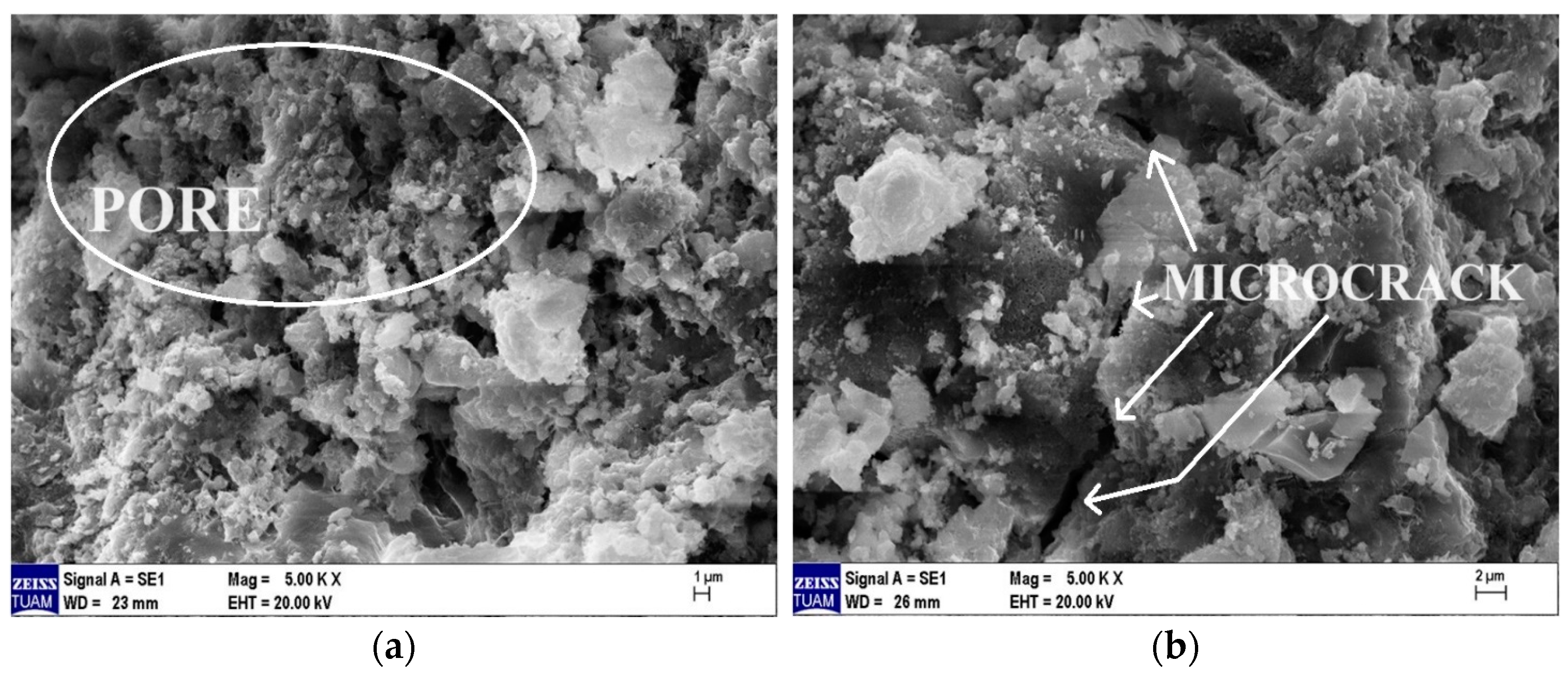
| Chemical Composition (%) | PC | MP |
|---|---|---|
| SiO2 | 24.32 | 10.03 |
| Al2O3 | 3.97 | 0.72 |
| Fe2O3 | 3.34 | 1.16 |
| CaO | 59.98 | 64.52 |
| MgO | 2.01 | 12.46 |
| Na2O | 0.36 | 0.22 |
| K2O | 0.42 | 0.39 |
| SO3 | 4.23 | 0.25 |
| Physical Properties | ||
| Specific gravity | 3.13 | 2.61 |
| Specific surface area (cm²/g) | 3395 | 2720 |
| Loss on ignition (%) | 1.43 | 9.96 |
| Mixture Code | PC (g) | MP (g) | Replacement of MP (%) | Water (g) | Sand (g) |
|---|---|---|---|---|---|
| Ref | 450.0 | 0.0 | 0 | 225 | 1350 |
| MP5 | 427.5 | 22.5 | 5 | 225 | 1350 |
| MP10 | 405.0 | 45.0 | 10 | 225 | 1350 |
| MP15 | 382.5 | 67.5 | 15 | 225 | 1350 |
| MP20 | 360.0 | 90.0 | 20 | 225 | 1350 |
| MP25 | 337.5 | 112.5 | 25 | 225 | 1350 |
| UPV (km/s) | >4.5 | 3.5–4.5 | 3.0–3.5 | 2.0–3.0 | <2.0 |
|---|---|---|---|---|---|
| Concrete Quality | Excellent | Good | Doubtful | Poor | Very poor |
Disclaimer/Publisher’s Note: The statements, opinions and data contained in all publications are solely those of the individual author(s) and contributor(s) and not of MDPI and/or the editor(s). MDPI and/or the editor(s) disclaim responsibility for any injury to people or property resulting from any ideas, methods, instructions or products referred to in the content. |
© 2023 by the authors. Licensee MDPI, Basel, Switzerland. This article is an open access article distributed under the terms and conditions of the Creative Commons Attribution (CC BY) license (https://creativecommons.org/licenses/by/4.0/).
Share and Cite
Bayer, İ.R.; Sevim, O.; Demir, I. Effects of High Temperature and Cooling Regimes on Properties of Marble Powder-Based Cementitious Composites. Buildings 2023, 13, 2527. https://doi.org/10.3390/buildings13102527
Bayer İR, Sevim O, Demir I. Effects of High Temperature and Cooling Regimes on Properties of Marble Powder-Based Cementitious Composites. Buildings. 2023; 13(10):2527. https://doi.org/10.3390/buildings13102527
Chicago/Turabian StyleBayer, İsmail Raci, Ozer Sevim, and Ilhami Demir. 2023. "Effects of High Temperature and Cooling Regimes on Properties of Marble Powder-Based Cementitious Composites" Buildings 13, no. 10: 2527. https://doi.org/10.3390/buildings13102527
APA StyleBayer, İ. R., Sevim, O., & Demir, I. (2023). Effects of High Temperature and Cooling Regimes on Properties of Marble Powder-Based Cementitious Composites. Buildings, 13(10), 2527. https://doi.org/10.3390/buildings13102527






